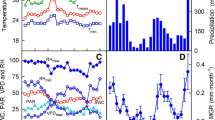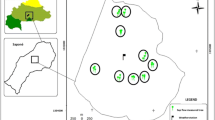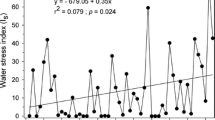Abstract
Droughts are a cyclical disturbance in Mediterranean ecosystems and climate change models forecast an increase of their frequency and severity. Some experimental and observational studies have shown that co-occurring species may cope with drier conditions with different strategies and present different responses. Here, we investigate sap flow response to drought in order to explain the observed differential growth and mortality of Quercus ilex and Phillyrea latifolia at Prades Holm oak forest (NE Spain). We measured sap flow of these species and compared their diurnal, nocturnal and seasonal patterns and their relationship with environmental variables. Both species described qualitatively similar daily patterns, either during daylight or night. Sap flow rates were significantly higher in P. latifolia except in autumn and spring. P. latifolia was more sensitive to soil moisture. Nocturnal sap flow was detected in both species with no significant differences and hourly rates suffered a progressive increase from 3 a.m. to dawn in most sampled nights. Our results indicate a better adaptation of P. latifolia to this site as it can take better advantage of wet periods while maintaining higher sap flow rates during dry periods. Along with previous ecophysiological studies at the same location it may be inferred that at its drier distributional limit Q. ilex would be at disadvantage with respect to other species like P. latifolia, as the latter would cope better with increasing xeric conditions already occurring and further predicted for Mediterranean ecosystems. Our results also show nocturnal sap flow to be relevant in individual water losses in these two species as they can be up to 35–40 % of daily sap flow. Further research on the underlying mechanisms of this nocturnal sap flow is required since it may also enhance early morning CO2 fixation or nutrient supply to leaves.







Similar content being viewed by others
References
Allen CD, Macalady AK, Chenchouni H, Bachelet D, McDowell N, Vennetier M, Kitzberger T, Rigling A, Breshears DD, Hogg EH, Gonzalez P, Fensham R, Zhang Z, Castro J, Demidova N, Lim JH, Allard G, Running SW, Semerci A, Cobb N (2010) A global overview of drought and heat-induced tree mortality reveals emerging climate change risks for forests. For Ecol Manage 259:660–684
Bucci SJ, Scholz FG, Goldstein G, Meinzer FC, Hinojosa JA, Hoffmann WA, Franco AC (2004) Processes preventing nocturnal equilibration between leaf and soil water potential in tropical savanna woody species. Tree Physiol 24:1119–1127
Caird MA, Richards JH, Donovan LA (2007) Nighttime stomatal conductance and transpiration in C-3 and C-4 plants. Plant Physiol 143:4–10
Carnicer J, Coll M, Ninyerola M, Pons X, Sanchez G, Penuelas J (2011) Widespread crown condition decline, food web disruption, and amplified tree mortality with increased climate change-type drought. Proc Nat Acad Sci USA 108:1474–1478
Cavender-Bares J, Sack L, Savage J (2007) Atmospheric and soil drought reduce nocturnal conductance in live oaks. Tree Physiol 27:611–620
Corcuera L, Camarero JJ, Gil-Pelegrin E (2004) Effects of a severe drought on Quercus ilex radial growth and xylem anatomy. Trees-Struct Funct 18:83–92
Daley MJ, Phillips NG (2006) Interspecific variation in nighttime transpiration and stomatal conductance in a mixed New England deciduous forest. Tree Physiol 26:411–419
David TS, Henriques MO, Kurz-Besson C, Nunes J, Valente F, Vaz M, Pereira JS, Siegwolf R, Chaves MM, Gazarini LC, David JS (2007) Water-use strategies in two co-occurring Mediterranean evergreen oaks: surviving the summer drought. Tree Physiol 27:793–803
Dawson TE, Burgess SSO, Tu KP, Oliveira RS, Santiago LS, Fisher JB, Simonin KA, Ambrose AR (2007) Nighttime transpiration in woody plants from contrasting ecosystems. Tree Physiol 27:561–575
Dodd AN, Salathia N, Hall A, Kevei E, Toth R, Nagy F, Hibberd JM, Millar AJ, Webb AAR (2005) Plant circadian clocks increase photosynthesis, growth, survival, and competitive advantage. Science 309:630–633
Donovan LA, Richards JH, Linton MJ (2003) Magnitude and mechanisms of disequilibrium between predawn plant and soil water potentials. Ecology 84:463–470
Fisher JB, Baldocchi DD, Misson L, Dawson TE, Goldstein AH (2007) What the towers don’t see at night: nocturnal sap flow in trees and shrubs at two AmeriFlux sites in California. Tree Physiol 27:597–610
Gucci R, Massai R, Casano S, Mazzoleni S (1999) Seasonal changes in the water relations of Mediterranean co-occurring woody species. Plant Biosyst 133:117–128
Gutierrez E, Campelo F, Julio Camarero J, Ribas M, Muntan E, Nabais C, Freitas H (2011) Climate controls act at different scales on the seasonal pattern of Quercus ilex L. stem radial increments in NE Spain. Trees Struct Funct 25:637–646
Howard AR, Donovan LA (2007) Helianthus nighttime conductance and transpiration respond to soil water but not nutrient availability. Plant Physiol 143:145–155
Infante JM, Mauchamp A, Fernandez-Ales R, Joffre R, Rambal S (2001) Within-tree variation in transpiration in isolated evergreen oak trees: evidence in support of the pipe model theory. Tree Physiol 21:409–414
Infante JM, Domingo F, Ales RF, Joffre R, Rambal S (2003) Quercus ilex transpiration as affected by a prolonged drought period. Biol Plant 46:49–55
Limousin JM, Rambal S, Ourcival JM, Rocheteau A, Joffre R, Rodriguez-Cortina R (2009) Long-term transpiration change with rainfall decline in a Mediterranean Quercus ilex forest. Glob Change Biol 15:2163–2175
Lindner M, Maroschek M, Netherer S, Kremer A, Barbati A, Garcia-Gonzalo J, Seidl R, Delzon S, Corona P, Kolstrom M, Lexer MJ, Marchetti M (2010) Climate change impacts, adaptive capacity, and vulnerability of European forest ecosystems. For Ecol Manage 259:698–709
Lloret F, Penuelas J, Prieto P, Llorens L, Estiarte M (2009) Plant community changes induced by experimental climate change: seedling and adult species composition. Perspect Plant Ecol Evolut Syst 11:53–63
Martinez-Vilalta J, Pinol J, Beven K (2002a) A hydraulic model to predict drought-induced mortality in woody plants: an application to climate change in the Mediterranean. Ecol Model 155:127–147
Martinez-Vilalta J, Prat E, Oliveras I, Pinol J (2002b) Xylem hydraulic properties of roots and stems of nine Mediterranean woody species. Oecologia 133:19–29
Martinez-Vilalta J, Mangiron M, Ogaya R, Sauret M, Serrano L, Penuelas J, Pinol J (2003) Sap flow of three co-occurring Mediterranean woody species under varying atmospheric and soil water conditions. Tree Physiol 23:747–758
Mereu S, Salvatori E, Fusaro L, Gerosa G, Muys B, Manes F (2009) An integrated approach shows different use of water resources from Mediterranean maquis species in a coastal dune ecosystem. Biogeosciences 6:2599–2610
Mueller RC, Scudder CM, Porter ME, Trotter RT, Gehring CA, Whitham TG (2005) Differential tree mortality in response to severe drought: evidence for long-term vegetation shifts. J Ecol 93:1085–1093
Ogaya R, Penuelas J (2003a) Comparative field study of Quercus ilex and Phillyrea latifolia: photosynthetic response to experimental drought conditions. Environ Exp Bot 50:137–148
Ogaya R, Penuelas J (2003b) Comparative seasonal gas exchange and chlorophyll fluorescence of two dominant woody species in a Holm Oak Forest. Flora 198:132–141
Ogaya R, Penuelas J (2006) Contrasting foliar responses to drought in Quercus ilex and Phillyrea latifolia. Biol Plant 50:373–382
Ogaya R, Penuelas J (2007a) Species-specific drought effects on flower and fruit production in a Mediterranean holm oak forest. Forestry 80:351–357
Ogaya R, Penuelas J (2007b) Tree growth, mortality, and above-ground biomass accumulation in a holm oak forest under a five-year experimental field drought. Plant Ecol 189:291–299
Ogaya R, Penuelas J, Martinez-Vilalta J, Mangiron M (2003) Effect of drought on diameter increment of Quercus ilex, Phillyrea latifolia, and Arbutus unedo in a holm oak forest of NE Spain. For Ecol Manage 180:175–184
Ogaya R, Penuelas J, Asensio D, Llusia J (2011) Chlorophyll fluorescence responses to temperature and water availability in two co-dominant Mediterranean shrub and tree species in a long-term field experiment simulating climate change. Environ Exp Bot 71:123–127
Penuelas J, Boada M (2003) A global change-induced biome shift in the Montseny mountains (NE Spain). Glob Change Biol 9:131–140
Penuelas J, Filella I, Llusia J, Siscart D, Pinol J (1998) Comparative field study of spring and summer leaf gas exchange and photobiology of the Mediterranean trees Quercus ilex and Phillyrea latifolia. J Exp Bot 49:229–238
Penuelas J, Filella I, Lloret F, Pinol J, Siscart D (2000) Effects of a severe drought on water and nitrogen use by Quercus ilex and Phillyrea latifolia. Biol Plant 43:47–53
Penuelas J, Ogaya R, Boada M, Jump AS (2007) Migration, invasion and decline: changes in recruitment and forest structure in a warming-linked shift of European beech forest in Catalonia (NE Spain). Ecography 30:829–837
Phillips NG, Lewis JD, Logan BA (2010) Tissue DT Inter- and intra-specific variation in nocturnal water transport in Eucalyptus. Tree Physiol 30:586–596
Quero JL, Sterck FJ, Martinez-Vilalta J, Villar R (2011) Water-use strategies of six co-existing Mediterranean woody species during a summer drought. Oecologia 166:45–57
Schiller G, Ungar ED, Cohen Y (2002) Estimating the water use of a sclerophyllous species under an East-Mediterranean climate I. Response of transpiration of Phillyrea latifolia L. to site factors. For Ecol Manage 170:117–126
Scholz FG, Bucci SJ, Goldstein G, Meinzer FC, Franco AC, Miralles-Wilhelm F (2007) Removal of nutrient limitations by long-term fertilization decreases nocturnal water loss in savanna trees. Tree Physiol 27:551–559
Snyder KA, Richards JH, Donovan LA (2003) Night-time conductance in C-3 and C-4 species: do plants lose water at night? J Exp Bot 54:861–865
Tognetti R, Longobucco A, Miglietta F, Raschi A (1998) Transpiration and stomatal behaviour of Quercus ilex plants during the summer in a Mediterranean carbon dioxide spring. Plant Cell Environ 21:613–622
Van der Zande D, Mereu S, Nadezhdina N, Cermak J, Muys B, Coppin P, Manes F (2009) 3D upscaling of transpiration from leaf to tree using ground-based LiDAR: application on a Mediterranean Holm oak (Quercus ilex L.) tree. Agric For Meteorol 149:1573–1583
Villar-Salvador P, Castro-Diez P, Perez-Rontome C, Montserrat-Marti G (1997) Stem xylem features in three Quercus (Fagaceae) species along a climatic gradient in NE Spain. Trees Struct Funct 12:90–96
Zeppel M, Tissue D, Taylor D, Macinnis-Ng C, Eamus D (2010) Rates of nocturnal transpiration in two evergreen temperate woodland species with differing water-use strategies. Tree Physiol 30:988–1000
Acknowledgments
This research was supported by the Spanish Government projects CGL2006-04025/BOS, CGC2010-17172 and Consolider Ingenio Montes (CSD2008-00040) and by the Catalan Government Project SGR 2009-458.
Author information
Authors and Affiliations
Corresponding author
Additional information
Communicated by M. Zwieniecki.
Rights and permissions
About this article
Cite this article
Barbeta, A., Ogaya, R. & Peñuelas, J. Comparative study of diurnal and nocturnal sap flow of Quercus ilex and Phillyrea latifolia in a Mediterranean holm oak forest in Prades (Catalonia, NE Spain). Trees 26, 1651–1659 (2012). https://doi.org/10.1007/s00468-012-0741-4
Received:
Revised:
Accepted:
Published:
Issue Date:
DOI: https://doi.org/10.1007/s00468-012-0741-4




